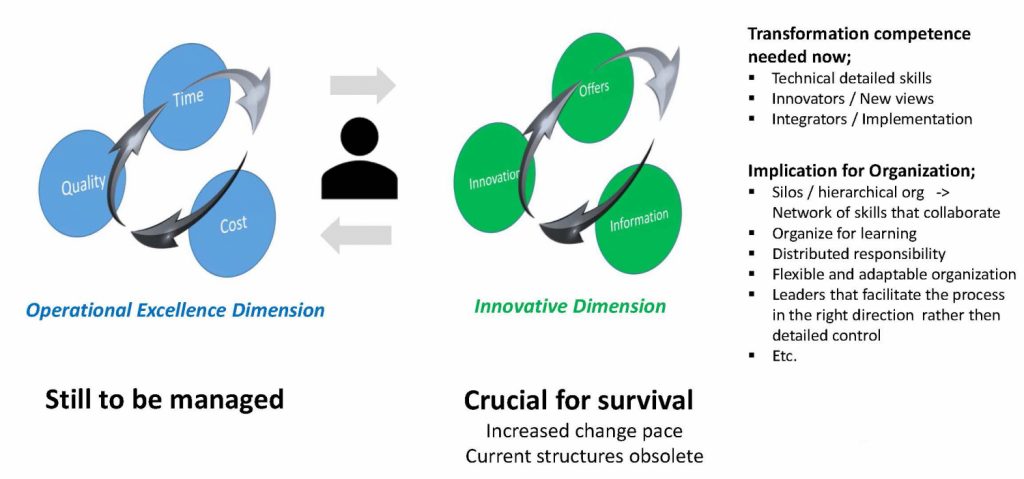Many companies today have a very challenging situation where they must both cut costs and lead times in existing processes and deliveries, while understanding new customer patterns and transforming the company towards tomorrow and managing the development of new services and digitization. To succeed with a continuous transformation towards tomorrow's business is often a vision of the future.
The dominant approach has long been "Operational Excellence" focused on existing operations and existing products. However, the challenge has long been to increase the degree of flexibility to handle volume variation, but also to manage an increasingly broad product mix.
Transformation Capabilities - Crucial for survival


Added to this is digitalization and increased focus on combining the delivery of a physical product with services. Many companies find it extremely tough to do all this at the same time and keep up the pressure in implementation. The concept of quality must be expanded to cover both of these dimensions if it is to succeed in the long term.
New way of managing Quality

More people need to be able to focus forward
This is an important and difficult balance, where one must also strive for increased quality and ensure learning in its innovative dimension. Unfortunately, many ambitious initiatives are launched, but there is often too much to do and they are often dragged out in time, often with poor results. In today's fast-changing world, the time factor is even more important, and late implementation can mean missing the boat.
It is obviously important to work with Q/T/C and strive for the"operational excellence dimension" in existing processes and delivery, but it is equally important to understand new customer patterns (customer journeys) and increase the transformation capability , what is called the "Innovative dimension". To achieve this, it is critical that current operations are streamlined and more resource-efficient, so that more people can focus on the necessary transformation.
Evolution and need for transformation

In the past, efforts have been made to first get the process and future needs in order, then the organization. Paradoxically, however, it is now necessary to bring on board a number of people who can contribute to the process of both defining and implementing the transformation, in a more iterative process where learning is central. It is good that the company has knowledge and an ability to use this knowledge in its operations, but continuous learning is increasingly important. If you first get all your processes in order and define future needs and then bring in people to do the job, you have missed the train again.
Defining a big picture of your business

More quarterly than annual
In many companies the vision and strategy have been dated on an annual basis, but this is far too slow a pace. The long-term vision is a bit more stable, but the strategy needs to evolve in a more iterative learning process, more on a quarterly than annual basis.
When navigating a terrain of high uncertainty, it is not possible to make detailed plans that cover longer time horizons. Instead, near-term planning and the ability to re-plan will be crucial. The important thing is to involve as many people as possible in the transformation and, with inclusive and goal-oriented leadership, ensure that the small steps are taken in the right direction and that people learn during this journey. Leaders in this type of organization more "facilitate" a journey, where the individuals in the organization take a broader and greater responsibility, and because they largely understand where you are going, less micromanagement is needed.

The company needs to ensure fast decision-making for critical issues, where hierarchical structures and sequential processes are often too slow. The picture below illustrates how to work cross-functionally for critical issues and ensure "handshakes" in a more continuous way. However, it is important to focus on the more complex issues that require an integrated approach and working together. All simpler issues must be handled directly by each group. They work together to ensure the smooth flow of information, money and deliveries. If any one of these three stops, you have major problems to deal with. Added to this is the need for transformation and innovation, where consensus is an important factor for success.
For a successful transformation, (some elements shown below) are needed:
- To streamline current delivery, freeing up resources to work on the future.
- Bring in people with the ability to work on transformation, but of course also train your existing staff.
- If you need to set a new structure for your delivery process, always think in terms of low complexity, modular architecture, flexible, scalable, full transparency, etc.
- Increased focus on understanding new customer patterns, which can lead to extensive redefinition of current delivery and where to draw the legal boundaries of the current company. Very important for creating pull in the business.
- In the same way that quality has gone from being a staff function and a few consultants who fix an "ISO-Cert" often focused on " operational excellence", to being part of the company's entire quality culture, including both "operational excellence & Innovation dimension".
- Transformation through innovation and digitalization is not a matter for a few, but something that permeates the entire company and becomes part of its DNA and culture.
Good luck and please get in touch if you want to discuss this topic further.
With kind regards,

Björn Fagerström
Professor Mälardalen University and Partner & Senior Consultant at Infobility
bjorn.fagerstrom@infobility.se
